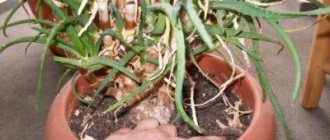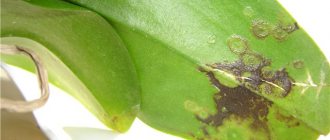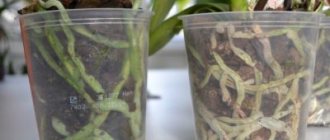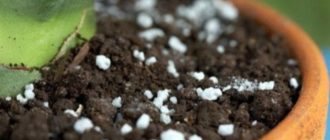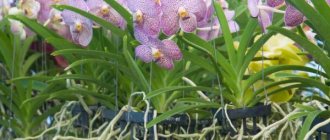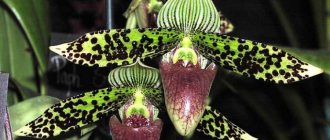Unfortunately, there are many diseases of orchids. Therefore, it is very important to know how they manifest themselves and distinguish between their symptoms. This will help you choose the right treatment method in a timely manner. And knowing the enemy by sight, you can even prevent his appearance.
Representatives of the Orchid family are extremely susceptible to rot, the sources of which can be both fungi and bacteria. Among these diseases, brown rot, black rot, root rot, fusarium rot and gray mold are often found.
Quite often, orchids suffer from diseases, the symptoms of which appear on the leaves. Such diseases also need to be able to distinguish. This may include leaf spot, anthracnose, and powdery mildew.
It also happens that orchids become infected with viral diseases. But, unfortunately, there is no escape from them. In this case, the diseased plant will have to be destroyed.
Brown (bacterial) rot
Phalaenopsis, cattleya, cymbidium and paphiopedilum are most susceptible to this disease.
If light brown and watery spots appear on the shoots and young leaves of the orchid, the plant most likely has brown rot. Over time, the spots may begin to darken, increase in size and merge with each other. Most often, this disease affects young leaves.
The damage process is especially accelerated by abundant watering and low air temperature in the place where the orchid is kept.
If the damage is minimal, the orchid can still be helped. To do this, using a sharp instrument, you need to cut out the affected areas to healthy tissue. Next, the cut areas should be sprinkled with crushed coal and treated with a copper-containing preparation, for example, Bordeaux mixture. After the “surgery,” the orchid should be kept in the conditions indicated for the specific species.
If the damage is too severe, then it is almost impossible to cure an orchid that has become infected with brown rot. No matter how pitiful the plant is, it is best to destroy it before the diseased flower infects the healthy ones.
To prevent brown rot, you can spray the orchid with copper sulfate once a month.
What to do if stickiness appears?
If sticky drops appear on the plant, you should stop fertilizing the plant and watering . A possible reason is overfeeding the orchid. To prevent rotting, you need to change the substrate. Another likely cause is overwatering. It is necessary to dry the top layer of soil.
Often a sticky coating is a sign of pests. Insects should be detected at the first suspicion. They are visible to the naked eye. These could be mites, scale insects, scale insects, and aphids. The leaves should be carefully examined both outside and inside.
Pests need to be controlled with chemicals and tablets . In order for the insects to manifest themselves, the flower is transferred to a hot room. The leaves are wiped, and with them the peduncles and flowers. Infected areas are cut off. The pot and the place where the flower was must be thoroughly washed.
Stickiness is also a sign of powdery mildew. At first it is a lot of drops, then a white coating with gray and black spots. It is necessary to cut off the affected areas and treat the plant with a fungicide.
Black rot
The fungus as the cause of this disease most often affects paphiopedilum and cattleya.
This disease usually occurs due to too low a temperature. Orchids are heat-loving plants, and if they are kept in the cold for a long time, they can develop black rot. The disease can also appear on plants that have been weakened as a result of attack by pests or due to existing other diseases.
The affected areas should be removed to healthy tissue with a sterile knife (or scissors), and the affected areas should be treated with charcoal or Bordeaux mixture. After this, the substrate in which the orchid grows must be disposed of, and the pot must be sterilized. When the plant is replanted, it should create conditions favorable for successful restoration.
It is almost impossible to cure an orchid, most of which is affected by black rot - all that remains is to get rid of the plant as soon as possible. But you can save neighboring orchids and other house plants. In the case of black rot, this can be considered a great success. To do this, treat the flowers standing next to the orchid with Bordeaux mixture or some other copper-containing preparation.
The best prevention of many fungal diseases, which include black rot, is to follow all the rules for caring for an orchid.
How to fight with chemicals?
Treatment of orchids with chemical fungicides is used if the plant is heavily infected and preventive measures have not brought the desired result.
According to experienced gardeners, the following fungicides are most effective:
- Pure flower is a systemic fungicide for production. For spraying, prepare a solution of 2 ml. funds for 5 l. water.
- Quadris is a broad-spectrum drug. Used to combat fungi and bacteria. The plant is sprayed with a solution of 1 ml. suspension for 2 l. water.
- Fundazol is a systemic fungicide. Creates protection against spotting, powdery mildew, snow mold, root rot and other fungal diseases. Pinpoint wounds are treated with foundationazole pulp (0.5 tsp of powder per 1 tsp of water), diluted with 1 tsp for spraying. powder per liter of water.
- Topsin M destroys fungal spores and mycelium, while simultaneously healing damaged areas. Additionally, the fungicide prevents infection of the plant by leaf beetles and aphids. The protective effect of the drug lasts 30 days.
- Captan 50W is a very strong and toxic drug, characterized by maximum effectiveness in the fight against anthracnose, black and brown rot, and rust.
- Scor is especially effective against powdery mildew, black rot and rust. Penetrates plant tissue and spreads through the vascular system. Completely blocks the growth of fungal spores and mycelium. Additionally increases the immunity of the orchid.
- Ordan is a combination drug containing copper oxychloride and cymoxanil. Thanks to these two components, it has a complex effect: it protects the plant from the inside and outside. Capable of restoring damaged tissue.
Carefully! When carrying out processing, it is worth remembering that all drugs are strong poisons, so additional precautions are required when using them. Preparation of solutions and spraying are carried out in an open space wearing personal protective equipment.
Traditional methods of treatment
Folk remedies for treating fungus on orchids are effective only in the first stages of infection. The purpose of their use is to stop the reproduction of spores and mycelium.
The plant is sprayed or wiped with one of the following products:
- Garlic tincture. 4-5 cloves are poured into 500 ml. hot water. Use the filtered infusion after cooling.
- Horsetail tincture. Crushed young shoots of the plant are poured with hot water in a ratio of 1 tbsp. l. per glass of water.
- Potato peel decoction. The raw materials are poured with water and boiled for 12 minutes. Then the broth is cooled to a temperature of 40 degrees and the plant is treated.
- Add 1 tbsp of soap-alcohol solution per liter of boiled water 40 degrees. l. alcohol and liquid soap. Orchid leaves are wiped with a solution.
How to get rid of pests?
Insect pests enter home orchids through open windows or from neighboring plants. Very often, flower growers themselves bring them along with a new flower from the store. If you do not quarantine the purchased plant, soon the entire home collection will be attacked by parasites.
Insects multiply quickly and can destroy an orchid in a matter of days. To avoid sad consequences, it is necessary to carefully monitor the condition of the leaves and begin fighting insects at the first sign of their appearance.
The first stage of ridding an orchid of parasites is mechanical cleaning with a cotton pad soaked in an alcohol solution. Then the plant is given a hot shower: placed in a bathtub, watered with a gentle stream of water at a temperature of 30-35 degrees. To enhance the cleaning effect, the leaves can be pre-washed with a solution of laundry soap.
Mechanical cleaning and showering help only at the first stage of infection. If the pests have multiplied, you can only get rid of them by spraying them with insecticides or acaricides:
- Fitoverm is an insectoacaricide based on biocomponents of contact-systemic action. For processing 2 ml. products are diluted in 250 ml. water. The effect of the treatment occurs after 6-8 hours and lasts 15 days.
- Akarin is a combination drug based on an alcohol extract of the streptomyces fungus. The concentration of the solution depends on the specific pest: for ticks - 2 ml. per liter of water, against aphids - 6 ml., thrips - 3 ml.
- Actofit is a broad-spectrum drug containing neurotoxins. To spray orchids, prepare a working liquid of 1 ml. products for 210 ml. water. The product is used only 2 times, then insects develop resistance to the active substance.
- Actellik is an enteric-contact drug that destroys adults and larvae. 1 ml solution. for 1 l. The plant is treated with water 2 times with an interval of 10 days.
- Tansar is an insectoacaricide based on synthetic pyrethroids. Protects the plant from insects for 2 weeks.
- Aktara is a contact-intestinal drug. Effective against more than a hundred pests. Insects die within 24 hours after treating the plant. The protective effect of the product lasts up to two months.
- Ethisso is a specialized preparation for exterminating pests in the substrate. Available in the form of sticks for placement in a pot.
To achieve maximum effect, after spraying the foliage, put a plastic bag on the plant. It is removed only two days after treatment. Most drugs are not capable of destroying insect eggs, so after 7-10 days the treatment of plants is repeated.
Important! To prevent re-infestation, treat the window sill and window frame on which the orchid stood with an insecticide.
What care does Phalaenopsis need after treatment?
Diseases and pests weaken the orchid's immunity, making it extremely vulnerable to re-infection. Additional stress for the plant is pruning and treatment with various preparations.
After treatment, the flower will take a long time to recover, and it will need special conditions and careful, careful care:
- The plant is installed in a room with moderate (22-23 degrees) air temperature in a bright, slightly shaded place.
- Water the flower in the morning moderately, even sparingly, slightly moistening the substrate. Soft water is used. Its temperature should not be higher than 30-35 degrees.
- The plant cannot be fertilized for 2 months after treatment. After this time, the solution for the first feeding is prepared, reducing the concentration by 4 times from that recommended on the package.
The orchid is a rather capricious plant, but resistant to diseases and pests. But if you are negligent and violate the rules of maintenance, you can seriously suffer. Recovering from damage is a long process. Therefore, the gardener should be attentive to the condition of the plant and promptly provide it with assistance if problems arise.
5/5 — (2 votes)
Root rot
Cymbidium, Miltonia, and Paphiopedilum are more susceptible to root rot than other orchids.
If an orchid is affected by root rot, the leaves of the flower begin to turn brown, and the roots rot and become soft. Too high a temperature and high humidity are often factors that accelerate the development of the disease.
It is worth starting treatment by creating favorable conditions for keeping the orchid, since the disease most often occurs due to violations in care. If an orchid is damaged by root rot, it is necessary to treat the roots and substrate of the plant with a solution of Fitosporin-M or the drug Trichoderma Veride, according to the instructions. To achieve a positive effect, it is advisable to carry out the procedure 3 times with an interval of 10-14 days. The easiest way to carry out the treatment is by immersing the pot in the solution.
When planting an orchid, you should use high-quality disinfected soil - this will be the best prevention of root rot.
Home care
A plant affected by a disease requires special attention. The orchid must be kept in quarantine until disease in other plants has been ruled out and complete recovery has been achieved. It is necessary to observe temperature and watering conditions, and constantly inspect the flower until all rescue measures are completed. You should also keep recently purchased flowers in quarantine.
It is important to maintain sufficient lighting conditions (place closer to the window, but exclude direct sunlight).
If the plant has suffered from lack of light, you can use a fluorescent lamp.
Spraying is a mandatory procedure for indoor orchids. Air humidity should be at least 60%.
Fusarium rot
Orchids such as phalaenopsis, miltonia, and epidendrum most often suffer from this disease.
This disease also refers to rot and is manifested by yellowing of leaves and the appearance of spots on them. The disease also affects young shoots. The easiest way to identify fusarium is by the leaf blades, which become soft, curl and may become covered with a pinkish coating (fungal spores). If this happens to your orchid, the prognosis is disappointing. The cause of the disease is most often the lack of air circulation in the room and high humidity.
To rid an orchid of fusarium, you need to treat it with Fitosporin-M solution for 10 days, immersing the pot with the plant in it 3 times a day. It is also worthwhile to completely stop spraying for a while, so as not to provoke the rapid development of the disease. It is also recommended to ventilate the room with orchids more often, while avoiding drafts.
The best protection for an orchid from fusarium is compliance with all necessary care rules.
Dangerous pests
The most dangerous orchid pests are:
- Mealybug, or feltworm (bristly, citrus). The bristly bug is red or orange, the citrus bug is pink or yellow. The insects seem to be sprinkled with flour on top. Pests feed on the sap of the plant and inject toxins into the orchid. As a result, the leaves turn red or yellow and then fall off. If the plant is not treated, it quickly dies. Infestation by the pest is indicated by white threads and sugary liquid on the leaf blades.
- Thrips. These are parasites about 2.5 mm in size, shaped like rods. They leave white spots and dots and a thin silvery film on the leaves. Thrips lay eggs deep within the leaf. Black dots form on the flowers, and constrictions appear on the roots.
- Nematode. Worms up to 2 mm long feed on plant sap. First, spots appear on the roots, then on the leaves and bulb. As a result, the leaves turn yellow and fall off.
- Spider mite. This is a tiny parasite that is difficult to see with the naked eye: its body size is about 0.3 mm. It lays eggs on green leaves. A symptom that may indicate a spider mite infection is a silvery coating that resembles a spider's web. White, yellowish or black dots also appear on the foliage. Spider mites feed on plant sap.
- Aphid. Insects come in different shades, but they can be recognized by their translucent body up to 2 mm. They usually live on the lower part of the leaf blade. Aphids feed on sap, causing the leaves to wither, curl, and dry out. The pest produces sticky dew on which sooty fungus develops.
- Bulb mite. The parasite has a body similar to a wide oval (narrowed at the back), measuring up to 1.5 mm. It feeds on the sap of the roots, as a result of which they become thread-like and hollow inside.
- Whitefly. The insect resembles a small butterfly up to 1.5 mm long. They have a longitudinal stripe on their front wings. Young larvae are motionless. The parasite feeds on the foliage, causing it to become variegated, red or yellow, lose turgor, and then fall off.
- Shield. The pest looks like half a match head up to 2 mm long. It lives on leaves and is inactive. The scale insect drinks the sap of the plant and secretes a sweet liquid, on which a sooty fungus then appears. Gradually the leaves dry out and the plant may die.
The substrate can be inhabited by slugs and snails, which eat all parts of the orchid. Another pest in the soil is podura. These are caterpillars of white, yellow, greenish, silvery shades, up to 2 mm long. They are capable of not only crawling, but also jumping. Podura appear in the soil with abundant watering. You can catch them by placing the pot in a bowl of water. The worms float to the surface and are collected on the water surface.
Another parasite is woodlice. The insect has an elongated body covered with armor, it is gray or yellowish marbled, up to 1 cm in length. The pest eats the orchid from all sides. You can get rid of woodlice in the same way as you can get rid of woodlice. If there are a lot of insects, the flower is replanted.
Various butterflies lay eggs on Phalaenopsis. The hatched caterpillars immediately eat the greens.
Gray rot
Phalaenopsis, cymbidiums and cattleyas, which bloom with white flowers, are susceptible to gray rot.
The presence of gray rot on an orchid is not difficult to determine: it is characterized by dark islands covered with a gray fluffy coating, which can be seen first on the leaves, then on the soil and ultimately on the flowers of the plant. Brown specks on flowers will also indicate the presence of this disease. Gray rot is a consequence of improper orchid care. The reasons for its occurrence are still the same - low temperature in combination with high air humidity. However, excessive application of fertilizers with a high nitrogen content can also cause damage to an orchid by gray rot. A high concentration of this element often leads to plants becoming less resistant to this disease.
If the orchid is severely damaged, the damaged areas should be removed and then the plant should be sprayed with fungicides, for example, Sporobacterin, according to the instructions. At the same time, it is worth noting that if the same orchid is again affected by gray rot, the same drug cannot be used. Fungal spores very quickly develop immunity against fungicidal drugs.
When watering an orchid, you can use special preparations that increase its resistance to disease. Then it will be possible to avoid the appearance of gray rot. And you shouldn’t forget about proper care of orchids either.
When placing orchids in a home flower garden, you should not place them close to each other. If one of the plants gets sick with gray rot, the disease can very quickly spread to neighboring plants.
Orchid
Dies
Due to complications occurring with the roots and leaves, the plant begins to wither. The question arises, what to do if an orchid gets sick? Need to:
- Know exactly what species the orchid belongs to;
- Determine on your own or ask on the forums what kind of misfortune happened to the flower;
- It is imperative to isolate the plant until complete recovery;
- Carry out treatment in accordance with the disease.
Stopped growing
It happens that an orchid slows down its growth or stops growing altogether. In this case there may be several reasons:
- An overfed and heavily stimulated plant was purchased;
- There are not enough nutrients - nitrogen in particular;
- The plant was attacked by pests;
- The orchid is sick;
- The conditions of detention do not meet the requirements.
An orchid may stop growing for various reasons.
In the first case, you just need to wait for the flower to adapt to your conditions. In the rest - determine the cause and take measures to eliminate them.
Read more about the reasons for stunted growth here.
Turns black
There are times when orchid leaves begin to turn black. There are reasons for this:
- Natural darkening. Plants that bloom very dark colors tend to tan in the sun. Some of them, if they do not get such a tan, will not bloom at all;
- Orchid disease. In this case, it is necessary to determine what disease the flower suffers from. It could be: Fusarium;
- Black spot;
- Black rot.
Read more about why an orchid turns black in this article.
Withers
The reasons for orchid wilting can be different:
- Frequent watering, the substrate does not dry out - the roots have rotted. It is necessary to remove the plant from the pot, cut off the rotten roots, sprinkle the cut areas with activated carbon or ground cinnamon, and let it dry. Plant it in a fresh substrate, correctly determining its composition, or plant it in an old one, and water only when it dries;
- Infrequent watering or incorrectly selected substrate . There are tribes of orchids that require more moisture-intensive soil. To eliminate the problem, you must either increase the frequency of watering or replant in a properly composed substrate;
- Orchid disease. Determine the disease and treat the orchid.
You can get more information about the causes of wilting here.
Dries up
The blooming beauty begins to dry out the buds for the following reasons:
- There is not enough light;
- Excessive lighting;
- Excessive or insufficient watering;
- Pests have settled on the flower;
- Orchid disease.
When leaves turn yellow and dry out, this could be:
- Natural aging of leaves;
- A recently purchased plant has an excess of fertilizers and stimulants;
- Mechanical damage;
- Insufficient watering, the plant begins to eat itself;
- Pests or disease of indoor beauty.
Dried phalaenopsis leaves.
If you see that your orchid is sick, what should you do? First of all, it is necessary to clearly determine what exactly caused this process. Make sure the plant is healthy and there are no tenants on it. Otherwise, take the necessary measures.
When it comes to flowers, adjust the lighting. Both lack and excess of light have a detrimental effect on flowering. In the first case, the orchid must be moved to a brighter place or additional lighting must be arranged. If there is a lot of sun, the flowers and leaves of the plant may simply burn. Adjust watering.
As for the leaves, you need to look at which side they begin to turn yellow. If the leaves dry out at the end, then this is either natural recycling, or the plant does not have enough water and nutrition - it is self-inflicted. It is necessary to water it with fertilizer , but without increasing the dose, and each watering is ¼ of the norm.
You need to take a closer look at the leaves turning yellow from the base:
- A new root is growing;
- Water has entered the leaf axil - remove the leaf by removing it from the trunk/pseudobulb and make sure that underneath it is clean;
- The trunk/pseudobulb began to rot. This problem can only be solved surgically;
A plant overfed by suppliers, finding itself in unusual conditions, begins to dry one leaf after another - throwing leaves. Sometimes this process can stop on its own, more often the plant dies.
Read more about the causes of drying out in this article. You will get the most detailed information about what to do if your orchid dries out from this article.
Turned yellow
Of course, orchids are tropical plants and the sun should not scare them.
However, quite often our, especially spring, sun can burn the plant completely.
This happens because the flowers wean themselves from the sun during our long winter.
Attention! To prevent the plant from getting burned, it must be accustomed to the sun gradually, shading it at first, or move the flower to another window where the sun only comes in the morning or evening. Phalaenopsis of the violacean group are most susceptible to this.
Another reason for flower yellowing is iron deficiency . In this case, it is necessary to spray with fertilizer with a high iron content, for example, Iron Chelate, a couple of times with a break of 10-14 days.
Read more about yellowing of orchids here.
Leaf spot
The development of this dangerous infectious disease, to which phalaenopsis is most often susceptible, is facilitated by too bright lighting in the spring and summer, improper watering and excessive fertilization. Leaf spotting can be determined by dark, wet spots that appear on weakened orchid leaves.
To save the orchid, you will have to remove all the affected leaves from the plant, and then spray the flower with a fungicidal preparation and not water it for the next 4-5 days.
How to treat if the leaves turn yellow?
The main reasons for this:
- lack of sufficient lighting;
- burns;
- lack or excess of nutrition.
If the leaf turns yellow from the tip and not from the base, then you need to move the plant to the light . If spots appear, then you need to exclude a burn: on the contrary, move it away from the light source. If ovals, yellow spots and stripes appear, then this is most likely a virus. The plant is incurable.
Wet, dark brown spots are bacterial infections. They are treated with peroxide (the flower is isolated). In case of fungus, damaged areas are removed, cuts are treated and a fungicide is used.
Not only the leaves, but also the entire plant can turn yellow. You can find out why this happens and how to save the plant here.
Anthracnose
Miltonia, oncidium, paphiopedilum, and phalaenopsis are most susceptible to the disease.
This disease most often appears on leaves and sometimes on pseudobulbs. Signs of anthracnose are small and round but distinct brown spots that may enlarge and coalesce over time. Large areas gradually become black and form dents. At a completely advanced stage, a yellowish or pinkish coating may appear on the spots. Most often, an orchid is affected by anthracnose due to too high air humidity, as well as stagnation of water in the axils of the leaves or in the core of the pseudobulbs. The causative agent of the disease is a fungus.
Areas affected by anthracnose should be cut off from the orchid and burned. The cut areas should be treated with activated carbon or ash. Copper-containing preparations, such as HOM or Horus, will help cure an orchid. They need to treat the flower three times with an interval of 10 days. After this, you should reduce watering and stop feeding the plant.
To prevent anthracnose from appearing on an orchid, it needs to be provided with air humidity of 40 to 70%. In addition, it is recommended to periodically ventilate the room with the flower so that the air does not stagnate, but circulates well. In addition, after watering, water from the leaf axils and cores of the pseudobulbs must be removed using a cloth or napkin.
Fungal diseases of orchids: how and how to treat diseases (with video)
Fungal diseases of orchids, which always accompany tropical plants under cultural conditions, are caused by various pathogenic fungi, which during their life processes are capable of releasing mycotoxins that poison plant tissue. Moreover, often the same mushroom is capable of releasing not one, but several toxins at once. Symptoms of the disease can also manifest themselves in different ways; they largely depend on the type of host plant, its general condition, and cultivation characteristics.
Anthracnose. Colletotrichum gloeosporioides (Penz.) Penz. &Sacc . - sexual stage, Glomerella cingulata - asexual stage of the same fungus.
A not very aggressive disease of orchids, which appears more often on the leaves than on the stems. Black spots on leaves or leaf tips have a yellow edge. The spots gradually grow, and over time, necrosis can spread to the entire leaf.
Control measures. The greatest activity of these fungi is observed at elevated temperatures and humidity in combination with low light. Therefore, at the first symptoms of the disease, it is necessary to immediately move the plant to a drier, cooler place, provide better lighting and good ventilation of the room.
The affected areas are removed, cutting off not only the necrotic spots, but also capturing another 1-2 cm of living green tissue. If the leaf is severely affected, it should be cut off completely. After each cut, the tool should be treated with vodka or alcohol; you can also heat the cutting surfaces of the pruning shears over a flame.
When treating this disease of orchid plants, sesame seeds should also be disinfected - sprinkled with crushed activated carbon or ground cinnamon, anointed with fungicidal paste or alcohol solution. I recommend using this set of measures for orchids affected by any fungal infections.
In the case of a severely progressing infection, it is necessary to remove the damaged areas and treat the diseased plants with zineb (0.4%), thiram (3%) or systemic fungicides, adding adhesives (a few drops of detergent).
Root rot (Fusarium oxysporum Schlecht.j).
This pathogenic fungus parasitizes not only the roots, but also other vegetative parts of orchids. This disease of orchid roots manifests itself in the form of rounded or elongated purple or pink-purple spots on rhizomes and pseudobulbs, which actively grow, affecting more and more areas of storage tissues of shoots, renewal nodes, and flower buds. The infection can penetrate inside the shoots through the roots, causing their death.
Symptoms of shoot damage are large reddish-brown weeping spots that quickly spread to healthy tissue. The leaves of orchids affected by Fusarium become spotted, turn yellow, thin and wither.
As you can see in the photo, with this disease of orchids, the edges of the leaves acquire a gray metallic tint:
Rot usually appears on unopened flowers, which turn yellow at the bud stage and soon fall off. The spread of this fungus is so fast that only about 20 days can pass from the moment of infection to the complete death of the plant. The use of fungicides can prevent the death of plants, but their shoots still remain severely deformed, the pseudobulbs are distorted and shriveled, and the roots die completely.
Control measures. First of all, a sick plant should be isolated from healthy ones to prevent the spread of infection. Then it is necessary not only to remove all diseased areas of the plants, but also to completely destroy them (for example, burn them). Preventive agrotechnical measures, such as disinfection of pots and drainage, are of great importance.
When replanting, only fresh substrate and new drainage should be used. Regular ventilation will also help prevent the spread of infection. As chemical measures to combat this disease of orchids, it is recommended to spray and water with a 0.2% suspension of foundationazole, benomyl or topsin three times in a row with an interval of 10 days.
Fusarium flower disease (Fusarium moniliforme Sheld. J.).
Sunken dark brown and black spots appear on flowers, buds and peduncles, which are covered like dust with whitish mycelium with small pink fruiting bodies. On the leaves, this disease manifests itself in the form of small spots; here, as a rule, there is no sporulation. The pathogenic fungus penetrates inside the plants through small wounds.
Control measures. This disease of orchid flowers very rarely manifests itself under conditions of proper agricultural technology with good ventilation. But if the pathogen is nevertheless identified, you need to remove all the affected parts of the plant, lower the temperature, increase the light and refuse to spray flowers and leaves, since Fusarium can spread with water droplets.
As chemical treatments, it is recommended to carry out the same measures as for combating other types of fusarium (see Fusarium oxysporum), as well as 3 times spraying with zineb (0.4%) every 4-7 days.
Core or crown rot (Phytophthora cactorum (Lib. et Cohn) Schroet.).
A wound parasite that produces strong toxins. Its mycelium extends within the tissues of the host plant, both between and through cells. The disease begins to appear on young shoots, leaves or roots, gradually capturing more and more new foci.
Pay attention to the photo - with this disease of orchids on the leaves, the first symptoms of infection look like small weeping spots, randomly located on the outside:
These spots quickly become purple-brown or black-purple, sometimes with a yellowish rim where they touch healthy leaf tissue. The damaged areas gradually enlarge and may release fluid when pressed.
With age, these lesions turn black and dry out, but when they come into contact with healthy parts of the plant, they can also transmit infection. In addition, the infection can spread through the internal tissues of the plant along the roots and rhizomes. This happens especially quickly in humid conditions.
Infestation of young shoots is easily identified visually by purple or purple-brown areas with yellowish edges. Most often, these symptoms appear with high air humidity and stagnation of water inside the leaf rosette of developing shoots.
Infection of pseudobulbs and rhizomatous areas of shoots through the roots is possible. In this case, the pathogen spreads through the internal tissues and may visually look like hemming of the base of the shoots and leaves.
Sometimes the infection is concentrated in the shoots, while the leaves do not show any signs of infection, but they become brittle and quickly fall off. On flowers, the infection manifests itself in the form of light brown weeping spots.
Control measures. Among the preventive measures to combat this disease of orchids is proper care with controlled temperature and humidity, which should not be too high.
It is also recommended to remove all parts of the plant that show signs of disease and refrain from spraying shoots and leaves in order to prevent the spread of infection through water droplets. When transplanting, a prerequisite is the use of clean, disinfected containers and drainage, as well as fresh substrates.
After removing all affected parts, the plants are sprayed with zineb (0.4%), spilled with Bordeaux mixture (1%), copper sulfate (1%) or powdered with thiram.
Black rot of orchids (Pythium ultimum Triw.j).
This pathogenic fungus enters the plant through the roots, spreads along the rhizome and infects the pseudobulbs and then the leaves. In this case, the pseudobulbs shrink, harden and mummify, and the leaves of the orchid with this disease become glossy black and soft to the touch. When pressed, liquid flows out of them. In conditions of excess humidity, leaf rot can occur from the tip.
Black rot kills orchids en masse and in a short time. Seedlings and young plants are especially affected by this disease. In seedlings, as a rule, the growth point located at the base of the shoot is the first to rot.
Control measures. Pythium develops more successfully in cool and humid conditions, so increasing the temperature and decreasing the humidity helps prevent the spread of the disease.
Since this infection is transmitted from plant to plant through water splashes, it is necessary to avoid spraying the plants and space the orchids more freely so that their leaves do not touch.
To treat this disease of leaves and roots as effectively as possible, you need to immediately cull all diseased plants - this is one of the most important protective measures to prevent the spread of black rot.
This especially applies to seedlings. You can try to treat adult plants by removing all affected areas and immersing them for 20-30 minutes. in a solution of copper-containing preparations - copper oxychloride (0.5%) or copper sulfate (1-3%).
If several orchid seedlings are planted in a common pot at once, not only the affected plants, but also all other plants must be soaked in the fungicide.
Leaf rot (Pythium splendens Braun.).
Orchid leaves affected by this disease become covered with oval or round dark brown spots. These spots have blurred edges, the color of which varies from dark brown to light brown and green, gradually merging with the normal color of healthy parts of the leaf. The spots gradually increase in size and eventually the leaf dies.
Rhizoctonia (Rhizoctonia solani JG Kuhn).
Although this fungus initially attacks the roots, the first symptoms of infection with this disease appear on the leaves, which turn yellow, thin and deformed. Young shoots develop suppressed, weak, and if the spread of infection is not controlled in time, not only seedlings, but also adult plants can quickly die. On the roots, the infection appears as brown rot with white and brown fungal hyphae on the surface.
Control measures. This disease is quickly transmitted from one plant to another, so it is necessary to remove and destroy diseased parts of plants, completely replace the substrate, and use sterilized tools and auxiliary materials (pots, drainage).
Often, root rot begins due to an unfavorable environment inside the pot, which is created when the substrate is regularly waterlogged, watered with hard water, or when the concentration of fertilizers is too high. In this case, you need to transplant the plant into a fresh substrate, providing it with good drainage and optimizing the salt concentration of irrigation solutions.
Among the chemical control measures, it is recommended to water the plants with systemic fungicides (benomyl (0.2%), foundationol (0.2%)), or spraying with zineb (0.4%), thiram (1-3%).
Methods for treating this orchid disease are shown in these photos:
Gray mold (Botrytis cinerea Pers.).
The manifestations of this disease (small gray, black or brown spots on flowers) are mainly associated with a prolonged decrease in temperature with high relative humidity. Often one cold night is enough for the flowers to become completely covered with gray rot.
Control measures. Among the preventive measures, it is recommended to refrain from spraying buds and flowers, as well as promptly remove faded and diseased flowers. In addition, increasing air circulation around plants, decreasing relative humidity and increasing night temperatures are recommended.
The infection can be transmitted by greenhouse pests (slugs, snails, insects), so it is recommended to constantly monitor their numbers.
Among the chemical measures to combat this disease of orchids, treatment with systemic fungicides is used - benomyl (0.2%), basezol (0.2%).
Leaf tip rot (Botrytis sp.).
The infection appears on the leaves as dark spots that gradually grow and move towards the ends of the leaves. The tips of the leaves become covered with spores. This disease most often appears on orchids watered with hard water or regularly receiving excess mineral nutrition. These plants have weakened leaf tips and are susceptible to Botrytis infection.
Control measures: As preventive measures, it is recommended to balance mineral nutrition and optimize the acidity of irrigation water.
To learn more about the treatment of orchid diseases, watch this video:
Phyllostictina (Phyllostictina capitalensis Henn. and others).
Spots can appear on both leaves and pseudobulbs. They initially appear as lighter whitish-green or yellowish oval or round shaped spots that eventually turn brown and black. The spots can be small or larger, in the form of dashes, ovals, diamonds or stripes. Each individual spot reaches no more than 6 mm in diameter.
If the infection progresses, black or dark brown sporulations appear in the center of the spots. The disease is transmitted through drops of water, poorly disinfected instruments, etc. From the moment of infection until signs of the disease appear, 3-6 weeks pass.
Control measures. Sick plants should be isolated by removing all affected areas. Since phyllosticosis develops rapidly at high humidity and temperatures above 25 ° C, this infection can be prevented by lowering the temperature, good lighting, regular ventilation and compliance with phytosanitary measures.
Among the chemical methods for treating this disease of orchid leaves, we can recommend spraying with systemic fungicides - benomyl (0.2%), foundationol (0.2%) and copper-based preparations - copper oxychloride, Bordeaux mixture, copper sulfate.
In the next section of the article, you will learn what viral diseases can affect orchids and how you can fight them.
Powdery mildew
All home orchids are equally susceptible to powdery mildew.
If an orchid is affected by powdery mildew, its leaves and buds become covered with a white coating. The disease causes the damaged areas of the plant to begin to dry out, and soon the flower dies. The development of the disease is promoted by high humidity and high air temperature. Such conditions are also called the greenhouse effect.
Powdery mildew must be combated as soon as its signs are detected on the plant. This will allow you to cure the orchid without significant losses. A solution of colloidal sulfur helps well against powdery mildew. You can also cope with the disease with the help of the drug Baktofit.
In order to prevent powdery mildew, the orchid should be sprayed with Fitosporin-M, according to the instructions.
What to do with lethargy?
Lethargic leaves are most likely due to insufficient watering . It is necessary to restore the regime; you can also soak the roots in a 0.1% solution of succinic acid (40 min.-1 hour).
If watering is excessive, you need to remove the plant from the pot and dry the roots. Then plant in looser soil. If overheated, move to a cool place. If lethargy occurs from root disease, then rotten and dried areas must be removed.
You will learn about what to do if the flowers of an orchid wither in our article.
Viral diseases
More often than other genera of orchids, a viral disease can affect cymbidiums, cattleyas, phalaenopsis and vandas.
The last thing you should be afraid of is viral diseases, since they rarely affect orchids. Most often they appear as mosaic spots on leaves and flowers. Also, in case of viral diseases, characteristic spots in the form of circles, stripes or arrows can be seen on domestic “tropicanas”.
Unfortunately, it is not possible to cure an orchid affected by a viral disease. If you suspect that something is wrong with an epiphytic pet, it should be urgently isolated from other plants. If the assumption is confirmed, then the diseased orchid will have to be disposed of.
Forewarned is forearmed. Now you know everything about orchid diseases and, if something happens, you can protect your plants from their silent enemies.
Diseases: photos and descriptions
Leaves
The first thing that catches your eye is the complications on the leaves:
- The leaves turn yellow;
- Leaves are limp, flabby;
- Cracks along the lobar vein;
- Convex growths, may have a wet rim;
- Silver color of leaves;
- Marble “ornament”;
- Darkening of the leaf blade;
- The young leaf has darkened;
- Dark spots with a yellow rim;
- Dry depressed dark spots;
- The leaves are covered with red dots, etc. and so on.
Some of them are quite harmless, such as the natural aging of an orchid or the tanning of a dark-blooming Cattleya. And some are very difficult cases in which the orchid will have to be disposed of and the place where it was located should be disinfected.
These signs are a consequence of various diseases that can affect orchids:
- Viral infections;
- Fungal infections;
- Various infectious diseases.
Manifestation of a viral disease.
Read more about leaf diseases in this article.
Roots
Root diseases always affect the outer part of the plant. If something is wrong with flowers or leaves, then last but not least you need to “look at the root.” The following can happen to the roots:
- Rotting;
- White web;
- Gnawed root tips, eaten away passages;
- Brown dust similar to ground cinnamon;
- Wet glassy roots;
- The tips of the roots have dried out and turned black;
- The roots in the substrate dry out;
- Depressed dark areas on the roots;
- Destruction of the base of the roots.
These symptoms may be caused by:
- Brown rot;
- Soil mushrooms;
- Infectious fungal diseases;
- Fusarium.
Attention! Treating without knowing what the reason is is guaranteed to ruin the orchid.
Read more about root diseases and their treatment with photos here.
Buds and flowers
Problems with buds and flowers are a consequence of disease of the plant itself , improper maintenance conditions or mechanical damage during transportation. Or they can be a natural process of the plant’s life:
- Flowers and buds wither and fall off;
- Peduncles get stuck (cattleyas);
- Dots, spots on petals;
- Flowers do not open completely or mutants open;
- Dry and depressed areas on peduncles;
- Sweet drops on the plant;
- Pale color;
- “Marble” coloring of flowers;
- Holes on flowers and buds;
Spots on phalaenopsis flowers.
Basically, these are completely harmless signs, but they may indicate that the orchid has:
- Fusarium in its various manifestations;
- Alternaria blight;
- Fungal or viral infection;
- Black spot (phyllosticosis).
You will get more information about diseases of flowers and buds here.
Stems
If you do not pay attention to the external signs of the plant’s condition, then the most unpleasant thing can happen - the disease will spread to the stem, rhizome and pseudobulbs.
Such advanced cases are much more difficult to cure and the flower may end up in the trash. It could be:
- Wet bacterial rot;
- Late blight;
- Brown rot;
- Various types of infections that began to develop on roots or leaves;
- Dry rot;
- Viruses;
- Black rot, when the orchid dies in a matter of days.
To prevent this from happening, you need to carefully monitor your plants and take timely measures to treat and prevent various diseases.
Read more about stem diseases in this article.
Rare
All plants coming to us from abroad undergo mandatory phytocontrol . It is quite possible that the check is only for the main types of infections. However, it happens that an orchid is sick with a rare disease that has not yet manifested itself on the ground part of the flower. So, what do orchids suffer from in rare cases:
- White rot (sclerotinia);
- Rust;
- Phomopsis;
- Anthracnose;
Anthracnose.
- Septoria;
- Alternaria blight;
- Cercospora;
- Phyllosticosis.
Attention! Diseases such as rust and Alternaria are very contagious and do not appear on the carriers of these diseases, but on nearby flowers.
Read more about these and other rare diseases of orchids in this article.
This article will tell you about the most common diseases.
Orchid diseases due to improper care
In addition to fungal and bacterial infections, which are also a consequence of improper care and suppression of the immune system, orchids can suffer due to excessive sunlight or too cold wintering.
Leaf burn
Burn on orchid leaves
Under natural conditions, epiphytes are hidden by the crown of the trees on which they live. The sun does not burn the fabrics, so they remain a deep green color. Nurseries use standardized artificial lighting, but at home, novice flower growers often place the orchid on an open windowsill without shading, so yellow spots form on the leaf blades - traces of burns.
In order not to dramatically change the living conditions of orchids, access to sunlight is limited by blinds or curtains. Gradually you can open them slightly, accustoming the plant to light.
The risk of getting a burn increases if the plant is sprayed during the day, in the sun, without shading after the procedure. The water drops act as a magnifying glass for the rays. You can check whether the orchid is suffering from the heat by touching the leaf plate. If it is hot, the flower must be immediately removed into the shade, then sprayed with a spray bottle to increase evaporation.
A burn stops the development of an orchid for a long time; after it, the plant takes a long time to recover and may drop buds or fail to set buds for flowering.
Frostbite
If beginners think that an orchid can get frostbite by standing on an unheated balcony all winter, then there is news for them:
- 30 minutes in a room with a temperature of +15 is enough for orchids in warm climates;
- The same time, but at a temperature of +2 degrees - for plants of cold temperature conditions.
Under such conditions, the flowers get frostbite - watery spots appear, from which water leaks onto the surface of the leaf plate.
How to revive a phalaenopsis that has lost its roots
First of all, remove the orchid from the pot. Carefully shake off any remaining substrate and inspect the underside of the plant. All rotten (and simply suspicious-looking areas) must be cut off with a sterile knife.
Then rinse the flower under the tap (lukewarm water) and lubricate the wounds with Fundazol powder. It is permissible to take iodine instead.
When the preparatory measures are completed, resuscitation of the phalaenopsis begins. If there are no roots left at all, then the plant must be placed in a greenhouse. The following conditions are created here:
- humidity about 80%;
- temperature not lower than +23°C and not higher than +28°C;
- backlight - 12 hours a day.
First place the flower in a new pot, one-quarter filled with drainage material. Place steamed sphagnum moss on top. Phalaenopsis must remain in this state until new roots form. Regularly spray the flower with water (substrate - water).
Tip: ventilate the greenhouse every night for an hour. It is during the dark hours of the day that the air contains the most carbon dioxide needed by plants.
It is also possible to revive the plant in another way. Prepare the orchid as described above. Then place it in a flask or jar (transparent and deep enough). Pour boiled or distilled water into the bottom. Its level should only slightly touch the bottom of the flower, but the liquid should not reach the leaves and stem.
Place the phalaenopsis in a warm room (at least +25°C) and protect from the sun. Keep the orchid in the container all day, and at night take it out and let it dry. Change the water daily. After about 2-3 weeks, new roots will appear.
The orchid roots rot and dry out, what should I do?
Most amateur flower growers believe that it is very simple to figure out whether an orchid’s root is dead or alive. It seems to them that it is enough to simply evaluate its color and that’s all.
So, they are convinced that healthy living roots will have a light color, and those that have died will have a dark color. But this is far from true. The fact is that the color of the roots of different species and varieties can be different, both light and dark.
In this regard, it is impossible to determine the state of the root system of such a flower by color.
The outer surface of the root is white, but inside it is empty
Many novice gardeners who do not have enough experience believe that the light color of the roots indicates that they are healthy and alive. However, if in some cases you cut such a root, you will see that the inside is completely dry and empty.
Is it bad that the spine is yellow?
In some cases, roots that are deep in the substrate may become yellow over time, and in some cases brownish.
This happens because they lack sunlight. Also, the color of the root system can be influenced by the substances that the plant absorbs from the substrate.
In this case, the dark color of the roots does not indicate that they are diseased or dead.
How to determine whether orchid roots are dead or alive?
You need to touch the spine. If it is quite hard and elastic, this means that it is alive. If you pressed on the root and it pressed through, this means that it is no longer viable, despite the fact that it may have a completely healthy appearance.
It also happens that when examining the root system, you can see an outwardly quite healthy root, but it only has a necrotic area in one place.
This root should be removed because it is no longer able to nourish the flower normally. This damaged root can also cause the orchid to become infected.
In this regard, an inspection of the root system of such a plant must be carried out with special care and all diseased roots must be removed.
A large number of gardeners believe that there is no need to worry about an orchid; if its green part located above the soil surface is green, then the whole plant is absolutely healthy. However, this is a misconception.
The fact is that pathogenic processes in the root system do not occur very quickly, and therefore even if it is sick, this will only be reflected in the green part of the plant after some time.
In this regard, a preventive examination of the orchid’s root system is very important, since during its implementation it is possible to detect diseased roots in time and remove them.
Why do the roots of an orchid die?
Main reasons:
- non-compliance with the rules for caring for this plant, namely: insufficient or excessive lighting, waterlogging of the substrate, drying out of the earthen clod in the heat;
- the flower is infected with a bacterial or fungal infection;
- The orchid is already very old.
What actions should you take if you find dead roots?
What you need to do first is to start caring for the plant, following all the rules. Such a flower can be “brought back to life” only if it is placed in the conditions that are most suitable for it.
A young root system can only grow if there are new shoots. And for their appearance, green buds are simply necessary, which must be alive. Therefore, it is necessary to try to find such kidneys.
Treatment of orchid roots
The root system of a diseased plant must be immersed in water for some time every day. So, after you immerse the roots in a container of water, you need to transfer it to the windowsill.
This procedure is best carried out at a temperature of about 20 degrees. Every day in the morning you need to add enough water to the container so that the roots of the plant are completely covered with it.
This plant should be in water for 1–2 hours, however, a longer “bathing” will not harm it.
In order for the sleeping kidneys to wake up, it is recommended to use baths with the addition of drugs that stimulate growth. So, it is recommended to pour only 1 drop of epin into a liter of water. However, you need to be careful with such baths and not do them too often. So, 2 baths per month will be more than enough.
How quickly will the flower recover? In each case it is individual. So, this may take 1 or 2 months in one case, 9–10 months in another, and some flowers never recover, despite all efforts. If you begin to restore your flower in spring or autumn, then the probability of success in this case is much higher.
The orchid has grown young roots, what to do next?
After you find young roots, you should not feed the plant any more from that day on. As a rule, such roots grow and develop very quickly.
When the new roots are five centimeters long, the orchid can be planted in a pot. It should be taken into account that watering the plant should be moderate, and the soil should not be allowed to become waterlogged.
Watering should be done only when the substrate is thoroughly dry.
Suitable substrate
The bark of medium and large fraction coniferous trees, sphagnum moss and a small amount of small charcoal are best suited for such flowers.
Secure the plant in a new container to prevent damage to young, fragile roots. To do this, you need to stick 2 sticks into the soil and tie a flower to them.
https://www.youtube.com/watch?v=bcGQw7TRj7I
You can also use the greenhouse method to restore this plant. You can purchase a greenhouse in a store or make it yourself from plastic bottles or an aquarium.
Loading…
Source: https://rastenievod.com/korni-orhidei-gniyut-i-sohnut-chto-delat.html
Tips and prevention
After buying a new flower, you need to quarantine it. Place the orchid in a separate room. After stress, the bush will adapt for a month in a new place. Treatment of rhizomes and leaves with tetracycline is allowed, although this does not always help.
Adviсe:
- It is better to spray the plants 2 times a day without affecting the flowers. In summer, water 1-2 times a week, in winter 1-2 times a month. You can’t water flowers with cold water, the roots will rot, heat the water to 35-40 degrees.
- To soften the water, place a piece of peat in a bucket wrapped in gauze, proportions 10 g per 10 liters of liquid. Water for irrigation is used purified, possibly melt or rain.
- Be sure to provide good drainage.
- Temperature changes should not exceed 4 degrees, the norm is 20-24 *C. The orchid is fertilized 1-2 times a month.
- For planting, light containers are used, holes are made in the pots for ventilation, holes are needed on the walls and bottom of the pot.
- You can maintain humidity using an aquarium; just place orchids next to it.
- For prevention, the orchid is sprayed once every 30 days with a solution of copper sulfate.
- Feeding plants with potassium will strengthen the plant's immunity.
- It is better to buy a ready-made mixture for orchids in the store; the substrate goes through all stages of processing.
- To combat moss or algae, wrap the pot in foil and place a dark flowerpot.
To make an orchid bloom, the pot is sent to a dark place with a temperature of +15*C. Phosphorus fertilizers are added and the humidity in the room is increased. Then place the pot in a dark corner for 5-6 days. After 3 weeks, buds appear that will bloom for a long time.
An infected orchid should not be thrown away immediately until all treatment methods have been tried. Strengthening the immune system is the main task in the fight against disease. A healthy plant will resist many infections. If you have purchased an orchid for the first time, you should seek advice on how to care for it so that the young plant does not get sick and blooms for a long time.
What is the danger
Any diseases interfere with the normal functioning of plants. Thus, rotten roots do not allow the plant to receive water and nutrients.
Leaves affected by bacteria, viruses or fungi stop carrying out photosynthesis - a specific process of converting light into chemical energy. As a result, new bonds arise, and carbon dioxide decomposes into organic components.
In the case of phalaenopsis, all this leads to a slowdown or complete stop of flowering - and this is the least that can happen. Many diseases are incurable - infection with them means a death sentence for an orchid.
Insects, absorbing phalaenopsis juice, thereby depriving it of necessary nutrition. As a result, the flower literally starves and withers.
Advice: pests mainly appear when the air becomes too dry, so regular spraying of flowers with water is an excellent preventive measure.
